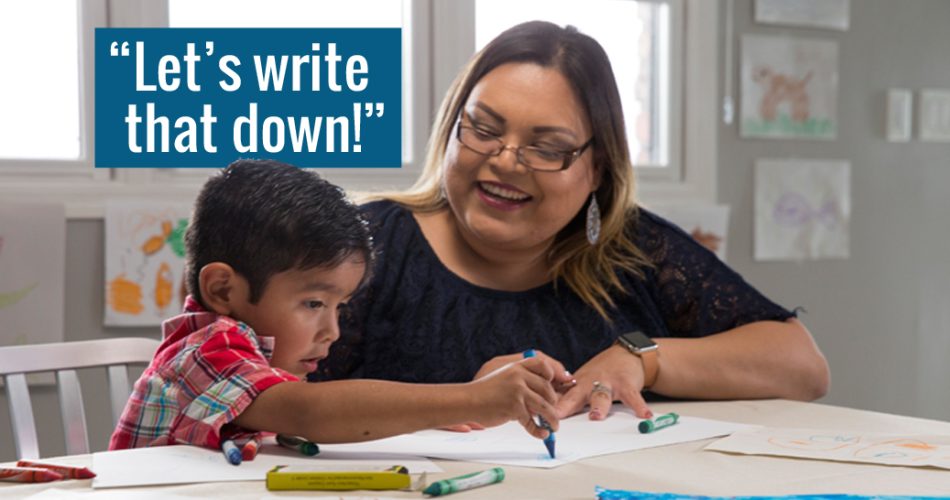As an early childhood educator, your role is to lay the foundation for future literacy development. Helping children birth to age 5 connect written and spoken language and having meaningful experiences with print can be a challenge, but one effective strategy is dictation.
Dictation–the process of writing children’s words and reading it back to them—helps children connect spoken and written language. Try these four ideas to introduce dictation into your classrooms or care groups.
Ask children to tell you about their drawings.
As children share their drawings, paintings and works of art with you, ask them to tell you about their work. As they describe their work, ask the child’s permission to write their words. Write down what they say, word for word, repeating the child’s words as you write.
As you dictate children’s words, you may decide to write directly on children’s artwork, on the back of the page, or on a separate piece of paper to attach to their work. What’s important is that you show respect for children’s work and provide a model of writing. Read back what you wrote, and encourage children to “read” their work and accompanying dictation to others.
Chart children’s responses.
Asking a “Question of the Day” can be a great way to provide an opportunity for dictation. If your daily routine includes group time, start the discussion by asking children a question about their experiences and ideas related to the topic you are exploring. For example, during a study of desert habitats, you may ask, “What animals live in the desert?” Write down children’s responses to your questions and hang these charts in your classroom to refer back to later, as you continue to study the topic.
Create group stories.
Young children love to create and tell their own stories. Make it a group activity by leading your students to author their very own story—with each child adding a sentence or two. Write down the children’s words as they add to the story, including just a short sentence on each page and leaving plenty of room for illustrations. Encourage children to work together to illustrate their story with pictures. You can bind these group stories in a notebook using clear sheet protectors—they are sure to become favorites!
Adapt your approach for nonverbal children.
Nonverbal children can also benefit from intentional connections between verbal and written language. For children who aren’t yet able to provide words for you to dictate, make a point to model your own writing. For example, during snack, you can model writing for children by stating, “We are almost out of milk. I’m adding milk to my shopping list, so I can read it later when I’m at the store.”
As you follow children’s interests, you will help them to make meaningful connections between verbal and written language setting the stage for success in kindergarten and beyond.
How do you engage your students’ interest in written language? What methods or activities have been successful in your program? Please share your story with us at QualityFirst@FirstThingsFirst.org.
